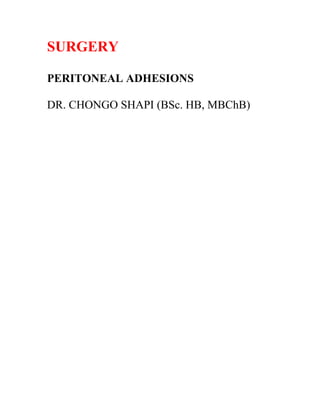
PERITONEAL ADHESIONS.pdf
- 1. SURGERY PERITONEAL ADHESIONS DR. CHONGO SHAPI (BSc. HB, MBChB)
- 2. PERITONEAL ADHESIONS Introduction Definition An adhesion is a band of scar tissue that joins two separate internal body surfaces together. Adhesions usually occur between two serous membranes which are close together. Adhesion formation after abdominal and pelvic operations remains extremely common and is a source of considerable morbidity. Adhesion formation occurs following any procedure, including cholecystectomy, gastrectomy, appendectomy, hysterectomy, colectomy, abdominoperineal resection, and abdominal vascular operations. The operations that frequently lead to adhesive obstruction include colon and rectal surgery, gynecologic procedures, and nonelective appendectomy. The incidence of intraperitoneal adhesions ranges from 67 to 93% after general surgical abdominal operations and up to 97% after open gynecologic pelvic procedures. Classification Congenial and Acquired A. Congenital Adhesions Are present from birth as embryological anomaly in the development of the peritoneal cavity (vitellointestinal bands, adhesions seen across the lesser sac). B. Acquired adhesions Are subdivided into inflammatory and post-surgical adhesions. Inflammatory adhesions Arise after intra-abdominal inflammatory processes, such as ➢ Appendicitis ➢ acute cholecystitis ➢ acute diverticulitis ➢ pelvic inflammatory disease ➢ Previous use of an intrauterine contraceptive device. The true proportion of each of these types is not known, but it has been reported that the majority of adhesions are postsurgical. Post surgical adhesions Results when injured tissue surfaces following incision, cauterization, suturing or other means of trauma, fuse together to form scar tissue. Recently, it was found that all patients who had undergone at least one prior abdominal surgery developed one to more than ten adhesions. Factors associated with the formation of post surgical adhesions include: 1.Trauma 2.Thermal injury 3.Infection 4.Ischemia 5. Foreign bodies. Multiple other factors, including: -Tight suturing, where tension within the sutured peritoneum produces ischemia, abrasions -Exposure to foreign bodies such as talc and powders from gloves, lint from abdominal packs, or fibers from disposable paper items, reactive sutures, intestinal contents, overheating by lamps, or irrigation fluid, may contribute to postoperative adhesion formation Such adhesions often contain multiple foreign body granulomas. This suggests a relationships between foreign material, foreign-body granulomas, and adhesion formation. Adhesions more likely to become obstructive are those involving the small intestine; however, intestinal adhesions occur less frequently than those involving the omentum. Most of the patients with adhesive intestinal obstructions have been found to have had surgery in the infracolic part of the abdomen, where the loops of small intestine adhere and become obstructed Microscopic examination of adhesions shows in a large proportion both suture and starch granulomas. Suture granulomas are often found in patients who recently underwent surgery Clinical Significance Importance and Complications from Intraperitoneal Adhesions Most common complications pf adhesions ➢ small-bowel obstruction ➢ difficult reoperative surgery ➢ chronic abdominal and pelvic pain ➢ female infertility Adhesions form between the wound and the omentum in over 80% of the patients, and they may involve the intestines in 50% of the patients Intra-abdominal adhesions are almost inevitable after major abdominal surgery. Re-operating through a previous wound can be extremely difficult, risky, and potentially dangerous. Also, adhesiolysis extends operating time, anesthesia, and recovery time and causes additional risks to the patient such as blood loss, visceral damage including injury to the bladder, enterocutaneous fistulas, and resection of damaged bowel. Intestinal obstruction Adhesions are the most common cause of large and small intestinal obstructions account for approximately one third to one half of all intestinal and for 60–70% of the small-bowel obstructions Congenital or inflammatory adhesions rarely give rise to intestinal obstructions, except for malrotation]. However, between 49 and 74% of the small-bowel obstructions are caused by post surgical adhesions Extensive soft adhesions will form within 72 h after laparotomy. These seem most extensive at about 10 days to 2 weeks, by which time they become dense and vascular. Over 20% of adhesive obstructions occur within 1 month of surgery, and up to 40% occur within 1 year . Obstruction by adhesions is usually the result of kinking or angulation or by creating bands of tissue that compress the bowel . Impairment of the local circulation of the small intestine due to strangulation is caused by adhesions in 30% of the cases. Although it is not clear how often adhesive obstruction recurs after conservative or surgical treatment, it is well known that adhesions create a lifetime risk of intestinal obstruction. An operation for obstruction due to adhesions carries a higher likelihood of recurrence than a laparotomy for other indications. The problem of postsurgical adhesions increases with the patient’s age, the number of laparotomies, and the complexity of surgical procedures. Simple adhesive obstruction may be resolved without surgicalintervention in the majority of the cases, in contrast to other forms of obstruction. According to recent series,up to 80% of episodes of partial small- bowel obstruction caused by adhesions resolve nonoperatively Injury or inflammation of the peritoneum triggers a coagulative state at the beginning of post surgical peritoneal repair that releases multiple chemical messengers at the injury site. Leukocytes, mesothelial cells, and fibrin play a major role in this cascade of events. Also present in the peritoneal cavity prior to surgery is a small amount of fluid that contains macrophages and plasma proteins containing a large amount of fibrinogen Following surgery, the macrophages increase in number and change function. These postsurgical macrophages are entirely different from the resident macrophages and secrete variable substances including ➢ cyclooxygenase and lipoxygenase metabolites,